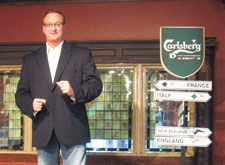
This economy has been great for customers. When the economy tightens, most exhibit builders and their salespeople resort to steep discounting in order to win more business. The result is lower margins, lower perceived value, clients become addicted to low prices, but not the value the account executive (AE) brings to the table. This does not portray lasting value to your client, nor a reason to expand the personal and professional relationship that must exist between an exhibit builder and their exhibiting company. This is not the way to grow a profitable business.
In order to succeed at winning business and growing sales, everyday must provide a valuable learning experience. These experiences come from unexpected places and in this economy, its important to have superior instincts to win business in a competitive marketplace.
As vice president of strategic development at LAB Exhibits, I am in a wonderful learning position. Everyday, I have the opportunity to learn from my clients, the young sales people that I mentor, and from the mistakes made by competitors. One of the biggest mistakes of competitors in growing the business is the balance between increased efforts in marketing versus increased efforts in sales. Too many people are relying on marketing in this down economy. In this time of economic uncertainty I am often confronted with the question; what has greater impact, marketing or sales?
While both of the disciplines, sales and marketing, are important to the growth of your companies, the balance must be made, and altered depending upon your client’s specific needs, capabilities as a valued supplier, and the economic conditions in the marketplace.
Marketing is the development and promotion of your company’s superior product and service offerings. Ensuring the customer they have made the right decision, and that your team will fulfill your client’s objectives, is crucial to growth. The issue I have with having a disproportionate amount of resources spent on marketing efforts is two fold. First, it is like a military’s carpet bombing campaign; it is almost impossible to use discretion in how the message is received and perceived by the customer. Also, there may be some collateral damage in being perceived as an expert in one market segment might be seen as a deterrent to another base of prospective clients. More often than not, the message created is more about the exhibit house than it is about the client’s specific needs. Secondly, most of the sales people in our industry are order takers and rely more on marketing campaigns to ring their phones than on their ability to develop and close business.
Sales, on the other hand, are hand-to-hand combat. You’re in the trenches with your customers in a one-on-one situation. What better way to understand their specific needs and pain points? Also, the skill required in developing and nurturing leads requires an AE to get out of their comfort zone, pick up the phone, and get past a loyal gate keeper to provide your value proposition to a decision maker. From my experience, 90 percent of the AE’s in our industry are order takers, and regardless of titles, not account executives. That’s the reason for stagnant sales and a decline in creativity in our industry.
In my quest to learn from other industry AE’s, I try to speak to as many people as possible while on show site, or at industry networking experiences. When I probe them for prospecting ideas in this recession I constantly hear the same excuse; our prospects are postponing purchases due to the credit crunch. Although polite in response, I often think to myself their sales team does not have enough qualified prospects in their pipelines to make up for the shortfall. Even now, there is business to be acquired, and the broad stroke marketing approach is not my preferred method of development.
Exhibit houses must arm their sales forces with strategies and tactics designed for selling in recessions, and in good times. These efforts must constantly be reviewed and altered each time you target a prospect. One of the most common mistakes management can make is allowing their AE’s to rely too much on existing clients rather than finding new business. Another management oversight is allowing mediocre sales people to give a lot of quotes and presentations, and then tolerating the lack of closed business from these opportunities. Furthermore, allowing salespeople to continually send expensive literature out only to end up playing phone tag with a voice mail recorder for the next few months. Account executives following these methodologies want their managers to see them as working hard and looking busy, all the while sales flat line and more commonly decline.
The top 5 tactics I use for stimulating sales and increasing prospects in a tough economy are:
Reactivate old leads. Although I have lost out in bidding situations, I see that experience as an opportunity for my competition to fail. This tactic is especially useful in generating interest from prospects two-years-old or less. Sooner or later I’ll be there to pick up the business.
Use existing clients to generate more sales opportunities. Whether it is building exhibits or designing print lay-outs for new advertising campaigns, I’m always saying; here’s an idea that can help you. Do you have a few minutes?
Utilize low cost add-ons to generate revenue while providing value. This can come in the form of booth reconfigurations requiring more product merchandising opportunity or inexpensive graphic applications. It’s usually the most obvious, not costly, solutions that the clients appreciate.
Always act professional and give your clients a genuine reason to like you. Let’s face it, when you’re busy, in demand, and have much more work than you can handle, it’s a great feeling. Most of the AE’s in our business have become prima donnas’. They are resented by their co-workers, industry peers, and in many cases, their clients. During times of success, the tendency is to get a swelled head. My advice is don’t. Treat each client with the utmost respect and like they’re your only client. Remember, in a depressed economy continuous business from ongoing clients is what keeps you afloat.
Postpone any dramatic fee/pricing increases. A recession, depression, business downturn, or soft economy is not the appropriate time for you to increase your fees or prices; even if you feel you deserve it and that a higher commission is long overdue. During such a period, you should defer any planned fee increase announcements until later, and instead, keep your fees at their current levels. Also, don’t announce to your clients and prospects that you are holding the line on prices due to the recession and your desire to help them through it. Remember, even though you are feeling the effects of a soft economy, they may not be going through similar difficulties. Thus, your announcement would clue them into the fact that you are in trouble and some may take advantage of your perceived need of business by haggling on price with you.
If you remain positive and consider rejection as an opportunity to overcome your next objection you will be successful. Exercise, memorize, and utilize the five tactics I have shared with you above, and you’ll be better tomorrow than you are today.
While marketing can send a powerful message to your customers and prospects, continually re-evaluate the balance between this message and the individualized aspect of one-on-one sales. While sales can place us in uncomfortable situations, it is the AE who persists under these circumstances that rise to the top of our industry. One of my favorite quotes, and one I have displayed prominently in my office, is by American advertising executive Bruce Barton. “Nothing splendid has ever been achieved except by those who dared believe that something inside them was superior to circumstance.”
Joe Houle is Vice President of Strategic Development at LAB Exhibits. Joe can be reached for comment and speaking engagements at jhoule@lbexhibits.com.






























